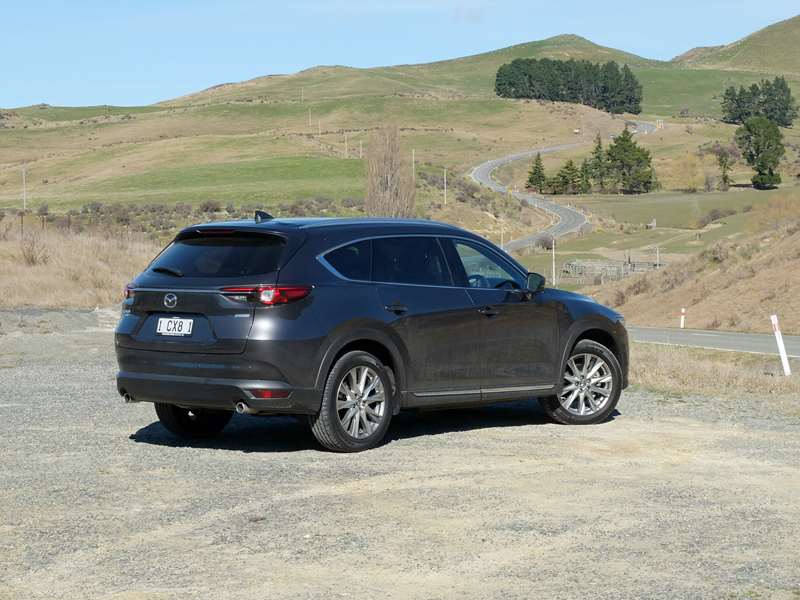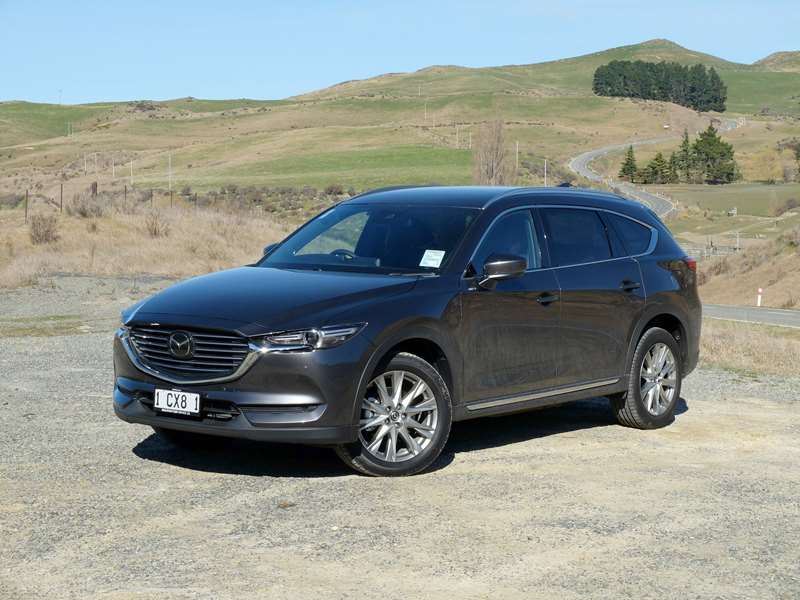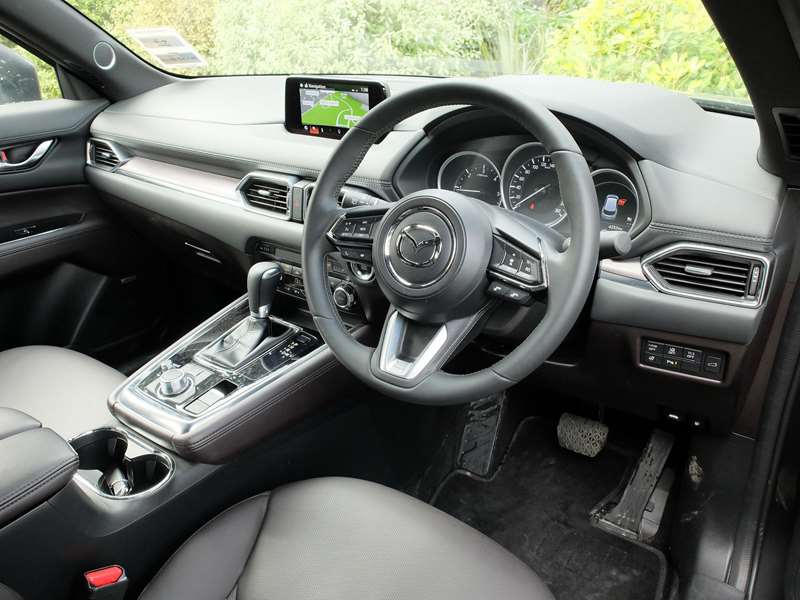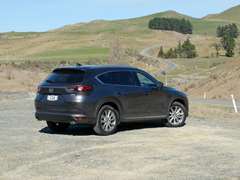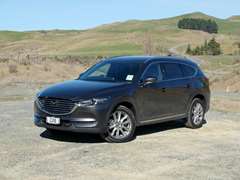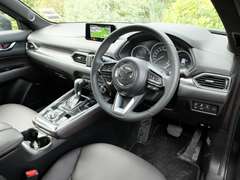| Price: | 62495 |
|---|---|
| Engine: | 2191cc twin turbo-charged four-cylinder diesel, maximum power 140kW@4500rpm, maximum torque 450Nm@2000rpm |
| Transmission: | Six-speed automatic, all-wheel-drive |
| Brakes and stability systems: | Front and rear disc brakes, ABS, EBD, ESP, BAS |
| Safety: | Five-star Ancap |
| Wheels and tyres: | Alloy wheels, 225/55 R19 tyres |
| Fuel and economy: | Diesel, 6.0l/100km on standard cycle, capacity 72 litres |
| Emissions: | 156g CO2/km |
| Dimensions: | Length 4900, width 1840, height 1730 |

What We Like
- All-round abilities with diesel character and economy

What We Don't
- Not as nimble as a CX-5 nor as sumptuous as a CX-9
Verdict
While not quite the best of both worlds, the CX-8 is still a fine machine
Rating:
Overview
When we run out of odd numbers, let’s try the even ones.
That seems to be Mazda’s approach as it seeks to meet global demand for its SUVs. With the CX-3, CX-5 and CX-9 already strong-selling, and CX-7 been-and-gone, what name would be appropriate for a new sports utility that slots in below the CX-9?
Enter the Mazda CX-8, available here in a three-model line-up comprising the front-wheel drive GSX at $53,495, the all-wheel drive GSX for $55,995, and a flagship all-wheel drive Limited (as tested) at $62,495.
From front and forward three-quarter angles, the CX-8’s visual similarity to a CX-5 is striking, but no surprise: the two vehicles use the same exterior panels from the B-pillar (that’s the one just behind the driver) forward. There’s familiarity under the bonnet, too: the CX-8 deploys the same 140kW/450Nm 2.2 litre twin-turbo Mazda SKYACTIV-D engine and six-speed automatic transmission combination as the diesel CX-5.
Behind that B-Pillar the stretch that takes the CX-8 out 4900mm — 400mm longer than its lower-numbered siblings — has been neatly executed, and the CX-8 gets a tail all of its own. It’s still 175mm shorter than a CX-9, and a little narrower and lower.
The cabin is a virtual CX-5 twin, with the same clean-lined dash, centre console, multifunction steering wheel, colour touchscreen, instrumentation and controls. But the split-lidded centre console/arm rest that separates the front seats comes from the CX-9.
The second row of seats replicates the excellent middle row of the CX-9, although narrower. Accommodating two in comfort or three with a bit of a squeeze, they are split 60:40, have a fold-down centre armrest, seat heaters and are mounted on rails for fore-aft adjustment.
Although Mazda bills the CX-8 as ‘‘five-plus-two’’ rather than a full seven-seater, the two third row seats are more generous than this billing suggests. Rising easily out of the boot floor, they should accommodate average-sized Kiwi kids through to their early or mid-teens, at which point headroom may become a factor.
When the rear seats are raised there is still a reasonable 209 litres of luggage capacity. That expands to 742 litres in five-seater mode, which is massively more than the CX-5’s 455 litres, and increases to over 1700 litres when the middle seats are folded flat.
Mazda has forged a reputation at the premium end of the mainstream Japanese brands over recent years, and the CX-8 reflects this in the quality of interior materials, equipment levels, fit and finish.
The GSX features a head-up display, tri-zone climate control, internet radio integration, and satellite navigation as standard. Its impressive active safety package includes radar cruise control, lane departure and lane keeping assist, blind spot monitoring and rear cross traffic alert, as well as automatic emergency braking.
The Limited augments this safety package with adaptive LED headlights, a more advanced smart braking system, and a driver attention alert system. Its additional creature comforts and convenience features include a premium Bose sound system, LED running lights and tail lamps, a power-operated tailgate, rear window privacy glass and sunshades, power-operated front seats, and heaters for the front and middle seats as well as steering wheel. It also comes with nappa leather rather
than cloth trim, and genuine woodgrain door and dash inserts.
My time behind the wheel of the CX-8 was unusually long, taking in part of Coastal Otago and South Westland, and traversing key points in Central Otago, on tarmac and gravel.
The CX-8’s 200mm of ground clearance is adequate for easier off-road trails. However, faced with damp conditions, and the combination of road-focused tyres, a fully automated four-wheel-drive system and a spacesaver spare, some discretion was required. A speedy run down the gravel access road from the Snow Farm to Cardrona was the non-tarmac driving highlight of the test, followed by gentle motoring on unmetalled trails around Bendigo.
As a vehicle for long highway trips, the CX-8 counts the comfort of its front seats and driving position as key assets, along with decent mechanical refinement and very good ride quality. Effortless cruising is facilitated by that torque-laden engine, which operates very effectively with the car’s automatic transmission.
Economy, at 7.8l/100km on test and 6.0l/100km on the standard cycle, is good, too.
Through the tarmac twists and turns of the Haast Pass, the test vehicle was a tidy handler, with decent turn-in and good resistance to understeer. Mazda’s very clever G-Vectoring Control system plays an important role in giving the CX-8 benign (and at times rewarding) handling.
Because it is taller and heavier than the CX-5, body roll is more obvious. In this respect, the CX-8 feels more like a CX-9. Road noise is generally well suppressed, but can become a minor irritant on coarse-chipped surfaces.
Around town, the CX-8 is an easy enough drive, but its 11.6m turning circle is not that tight, and its rear-view camera is an essential companion when reversing.
All in all, the new CX-8 has plenty to commend it, as a vehicle that genuinely combines most of the best features that sit either side of it in Mazda’s burgeoning sports utility range.
- by David Thomson
